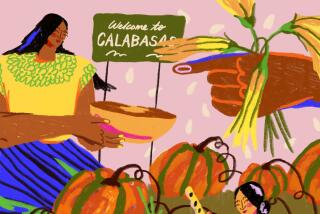Little Kernels a Big Issue in Rhode Island
- Share via
LITTLE COMPTON, R.I. — Perhaps it’s not surprising that a state with a chicken and a clam as mascots would be sentimental about corn.
It’s not just any corn, however, that Rhode Islanders propagate and debate in the General Assembly--it’s the kind it takes to make Rhode Island johnnycakes. The flat rounds of cornbread are made from the flour of white cap corn.
Only that particular strain, a locally grown, hard, amber-colored flint corn, can be called Rhode Island corn. (A law passed in 1940 sets a $100 fine for mislabeling corn.)
“Johnnycakes are serious business,” Rhode Island Secretary of State Kathleen Connell said. “The corn is temperamental and you have to put it in the freezer or it gets bugs, but it certainly is a special flavor when it’s done right.”
The johnnycakes, made only with cornmeal and milk or water, originally were baked in embers or on a board. Now they are fried on a griddle or a skillet. They can be eaten hot or cold with butter, gravy or cream. Some people douse them in syrup and eat them as a dessert.
The johnnycake has been a staple here in the smallest state for more than 300 years--ever since the Colonists learned about the special corn from the Indians.
“It wouldn’t be a Rhode Island johnnycake if it was made with something else,” said Paul Pieri, 37, considered the state’s No. 1 producer of white cap corn.
Rhode Island white cap has a high oil content and a nutty flavor. Experts say it is the only true strain of native corn surviving in New England. It was the most common corn crop in the state through World War I, and continued to be popular through the 1940s, Pieri said.
Today, only 40 to 60 acres of Rhode Island are planted in johnnycake corn, according to Stephen Volpe of the state’s agriculture division. Roughly 2,000 to 3,000 acres are planted in other types of corn, he said.
Pieri, who has about 20 acres in white cap, said that maintaining a healthy crop is a time-consuming, painstaking process and he must select the seed corn carefully.
“It’s very susceptible to a lot of diseases,” he said. “It’s not very vigorous. It’s not very productive and it’s not very resistant to insects.”
Michael Sullivan, the botanist in charge of the University of Rhode Island’s five acres of white cap, said has been experimenting with ways of producing a hardier strain, but he knows that purists may reject his efforts.
Pieri had a master’s degree in outdoor education and no agricultural background before he turned to farming 10 years ago. He said he chose to grow the white cap corn because he wanted a crop he could raise without pesticides.
Besides, “I really like the history behind it,” he said. “I wouldn’t enjoy harvesting cauliflower as much as I enjoy harvesting the corn.”
The Society for the Propagation of the Johnnycake Tradition in Rhode Island, founded in 1972, is experiencing a resurgence after years of inactivity, according to member Nancy Holst, who is 83.
The group plans a year of educating elementary school students “on how Rhode Island white cap flint corn was grown in the past and how it is grown today,” she said.
“I don’t think it will ever go completely,” said Secretary of State Connell. “We see (johnnycakes) every time we have a heritage function.”
There are two versions of johnnycakes--the thick patty preferred on the west side of Narragansett Bay and the thin, crisp version eaten on the east side.
In 1922, a state representative from Portsmouth lobbied to have the thin Newport County johnnycake adopted as the official version and a virtual war erupted.
More to Read
Sign up for Essential California
The most important California stories and recommendations in your inbox every morning.
You may occasionally receive promotional content from the Los Angeles Times.












